Now that’s more like it. Choice! Side-missions! A hub! A strong supporting cast who are up for a bit of a chat! Little-to-no mandatory decking sequences! A mother-lovin’ save (almost) anywhere system!
Shadowrun Returns: Dragonfall being ‘just’ DLC for last year’s cyberpunk/fantasy mash-up RPG is bittersweet, because it may well be that only existing Shadowrun Returns owners give it a spin. Really, though, this is the point where new players are best off getting involved – a new, superior campaign with no ties to the last one, and quite a few of the major problems dealt with. Now’s the time to play Shadowrun Returns, basically, but please, start with this.
The elevator pitch is the same as last time around: elves, dwarves, trolls and orcs living (slightly uncomfortably) alongside humanity on a near-future Earth, where the lines between technology and magic are blurred, and crime – street, organised and corporate – is rife. Techno-D&D basically. In Dragonfall, the setting switches from Seattle to the Free City of Berlin, which turns out to look a lot like Bladerunner’s Chinatown. But then, that’s basically what we expect of cyberpunk worlds, isn’t it?
You play a character of your own creation (I went for a fight-fighting magic dwarf, a sort of half-height Iron Fist), newly recruited to a team of Shadowrunners led by an old friend. (Shadowrunners are basically the A-Team, only they’ll work for bastards too). Bad Shit promptly goes down, and you find yourself in charge of this small gang of underground ne’er do wells as they attempt to Uncover Secrets! / Defeat Conspiracies! / Protect The Innocent! / Save The World! / Find And Stop A Bloody Great Dragon! / That Sort Of Thing!
Reams of hard-bitten, colourful-but-not-too-colourful dialogue frames all of this, and I found it agreeably, enjoyably pulpy in its take on noir meets fantasy quest. It creates tone rather than distracts from it, and bar a few instances of getting too carried away with itself, the writing seems to understand that it’s essentially working with genre stereotypes. It enjoys them and entertainingly embellishes them rather than tries to hide or overcomplicate them. At least, I hope so.
The rest of your team are a great case in point, and evoke Bioware companions at their best, even if they are realised in far more limited and ultimately brief way. Your tattooed, skinhead, fiercely anti-specist shaman used to be the lead singer in a British punk band. (“So you can sing?” “Of course not – I was in a punk band.”) The team medic is fitted with so much ‘chrome’ (tech augments) that she’s in danger of losing her soul – but perhaps you can reach her? The hulking troll weapons specialist is ex-military and aggressively reluctant to give you her respect or trust – and thus achieving this becomes an even more powerful motivator than stopping the big nasty dragon, or whatever it is.
They’re
fun. They’re not there to be taken seriously (again, at least I hope so), they’re there to be enjoyed – genre staples done well, and with affection. Dialogue offers choice aplenty on how to interact with them between missions, and while concrete consequences may be few, knowing that you’ve got through to someone, heard more of their inevitably dark history or royally pissed them off builds a great sense of team dynamic, and who these people are outside their combat abilities. Dragonfall also has a neat line in punishing you for being overly obsequious in the hope of reward – team mates and NPCs often called me out for being mawkish or superficial when I defaulted to the ‘nice’ option, and that only made me respect them more.
A similar philosophy extends to the missions and quests. While the storyline is really only headed in one direction, I was pleased to find that there’s a great deal more meandering and branching than in the original Shadowrun Returns, but it’s there to build tone and character rather than truly drag the plot off to alternative places. Sure, you’ll get a few bonus Karma points (spent on new or improved stats and abilities, basically) if you find and choose the option to save the semi-friendly ghouls in the sewers rather than kill or evict them, but whatever you do that’s the end of it and it’s on to the next thing. What matters is that you’ll either feel you’re a sensitive hero-to-all, or a ruthless utilitarian who doesn’t mind sacrificing a few lives in the pursuit of a job well done and/or filthy lucre.
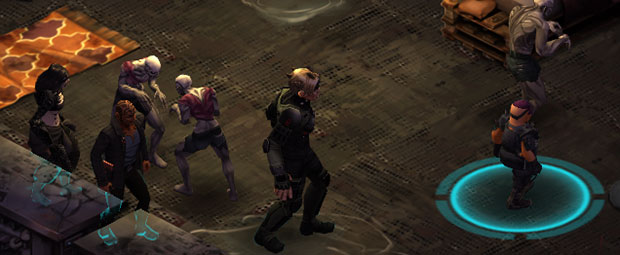
It’s about swaddling yourself in this surprisingly colourful world of crime and grime in the way that you see fit, rather than trying to pretend you’re able to affect sweeping changes to it. To a limited degree, you’re also able to pick and choose missions – most are mandatory, but there were just enough that were optional that I felt I was playing on my terms rather than the game’s.
The improvement on the parent game in this regard is subtle at first but far more dramatic in the long term. You’re still being railroaded by the plot, but the ability to control the pace makes this a very different animal. The Seattle campaign too often felt like a lightweight point and click adventure interspersed with sporadic, overtly scripted turn-based combat scenes and too much backtracking, whereas this feels much more like a roleplaying game. This extends to in-mission too – most challenges (which invariably means a locked door by any other name, to be honest) have a least of couple of possible solutions that you and your current team may or may not have the right abilities to pull off – e.g. getting your Decker to hack a terminal, getting your bruiser to shoulder open a secret door, using the right, Charisma-derived Etiquette to sweet-talk a corporate drone into letting you by. And if all else fails, there’s always the Kill Everyone approach too.
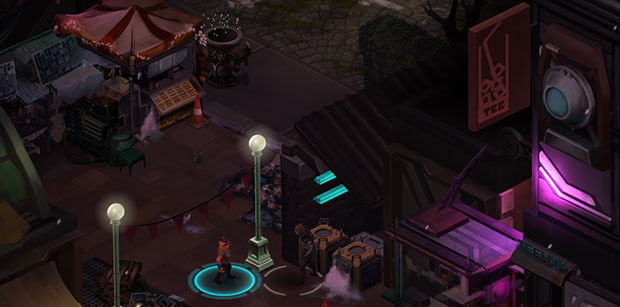
Again, you are going to get past that door and onto the next plot nugget no matter what, but Dragonfall seems well aware that feeling like it was done in a way particular to your character makes all the difference. Those who found the mandatory ‘Decking’ sequences (VR-world combat) in the parent game galling will be glad to hear that they are now optional, usually available as one possible means of overcoming an obstacle if you have the appropriate character in your party.
Combat is as combat was, a solid if unexceptional take on the turn-based fare of original Fallout and X-COM, with added magic and perhaps not quite enough sense of risk. More choice of who to take with you (filling your three team slots with either favourites from your Shadowrunner chums or hired mercs for variety’s sake) and the between-mission getting to know you stuff means it doesn’t feel like you’re out there with a bunch of disposable ciphers. It’s perhaps a little bit throwaway, but that is in keeping with the pulpy, good times vibe of the whole thing.
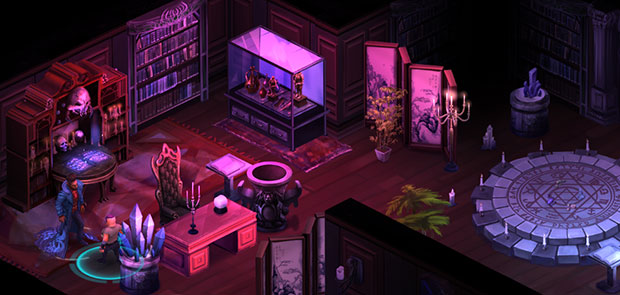
For all the improvements, there is a strong sense that Dragonfall is straining against Shadowfall Returns’ inherent limitations. All these choices I’ve mentioned involve simply picking one line of text over some others, usually with no animation pay-off – usually the result is simply described. Outside of combat, the lavish, detailed backdrops are really just that – scenery for a colourfully-written text adventure. You’ve got to allow yourself to live in the text, otherwise I fear you may well bounce off Dragonfall, for all its improvements. At its heart it’s a game about click-click-clicking through a lot of dialogue, but the big difference here is that there’s a much stronger sense you’re affecting that dialogue rather than merely being subjected to it.
The biggest problem for me was a certain inconsistency in how you can use your party members. Levelling up and equipping new items is limited to just the main character, even to the point that you can’t tell someone else in the party to equip a found health kit if you’re out of inventory space. Exciting weapon drops wind up deflatingly pointless because you can’t give them to seemingly-suited characters. The game’s stuck in an odd, frustrating half-way housed between team-based and single character, and while I really enjoyed chatting to my squad mates, I’d almost prefer it had gone fully one way or the other.
Meanwhile, one computer terminal might give you the option to send your Decker team mate in to hack it, but the next might grey out the hacking option because you’re not a Decker yourself. Dragonfall too often feels arbitrary, as though it’s trying hard to always present options then worrying that it’s given the player too much power to resolve anything. Clearer lines are needed.
There’s also a little too much schlepping around the main hub area, which has gone to great lengths to be pretty and relatively rich with world-building optional conversation, but is at the same time a very large plaza to tediously trot back and forth across when you’re trying to visit all the relevant shopkeepers and quest-givers. And it has the same issue that so much of the game’s art does – it’s essentially static, using superficial prettiness as cover for being nothing more than a background. I am OK with that, as I’ve got enough out of the character work and fiction to shrug it off, but whenever I look at Shadowrun Returns (in either campaign) too closely I become naggingly aware of how much it seems like a game assembled from a kit.
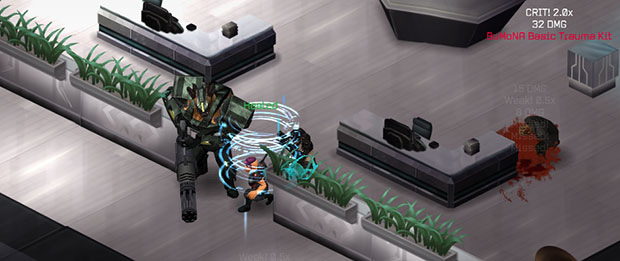
The trick, then, is to just go with it. Enjoy the setting, enjoy the characters, enjoy the X-COMy combat, enjoy being a hero or a thug in a world of magic and technology. Dragonfall’s a big improvement on Shadowrun Returns even if it is inescapably the same game, and it pulls off the smart trick of being both a superior starting point and a more satisfying follow-up.
Oh yeah, and the new save system just works. Sure, there’s an element of feeling like a cheat when you can quicksave ahead of a dilemma or challenge, but I’ll take that over replaying long segments in the event of a failure any day.
Shadowrun Returns: Dragonfall is out today. It costs $15/£12 and requires a copy of Shadowrun Returns.



























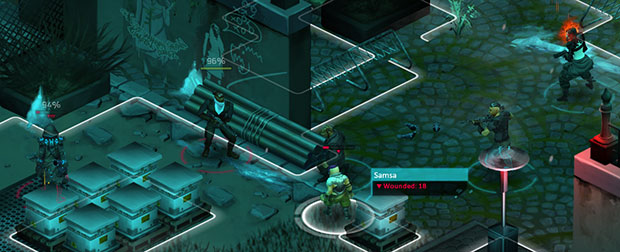



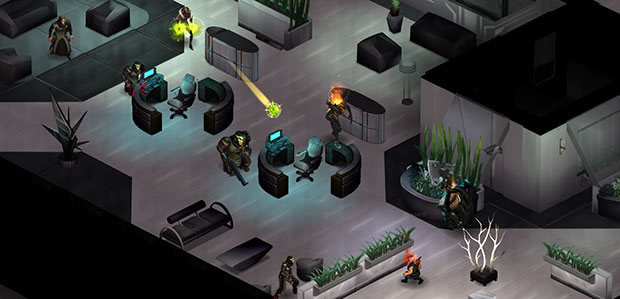



![Glory to Codexia! [2012] Codex 2012](/forums/smiles/campaign_tags/campaign_slushfund2012.png)





